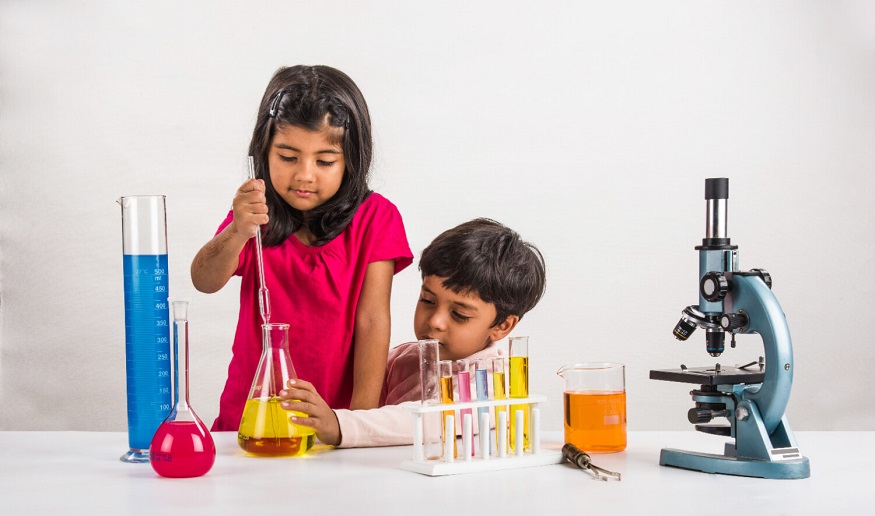Science is a fascinating subject and keeps throwing surprises at us. Science also develops logical and critical thinking in children and stimulates their curiosity. It encourages them to question the ‘how’ and ‘why’ of what they experience around themselves. It motivates them to explore and find out things for themselves. The more questions a child asks, the more they learn. So the next time your child is bored, try to ignite their inquisitiveness by telling them some interesting scientific facts. There are so many aspects and branches of science that it is impossible to even cover a small part of them in this blog.
In this blog, we will give you 50 interesting facts about science that are sure to amaze your child and keep them wanting more.
- Water bodies cover 70% of the Earth.
- Parrots and rabbits can look behind without turning their heads.
- Humans and koala bears have the same fingerprints which can really create confusion at a crime scene.
- The horn of a rhinoceros is completely made up of tightly packed hair.
- Bats always turn left when exiting a cave.
- Ostriches have bigger eyes than brains.
- The diameter of the Earth is about 109 times smaller than that of the Sun.
- There are about 2000 storms somewhere on the earth every minute.
- Dead skin comprises most of the dust we have in our houses.
- You cannot sneeze with your eyes open. Try it!
- We have 300 bones in our body at birth. These merge so that we have 206 bones in adulthood.
- Humans get a little taller in space as there is no gravity to pull them down.
- The moon has no light. What we see at night is the light of the Sun that reflects off the moon and reaches the Earth. You are actually looking at sunlight.
- Strawberries have seeds on the outside.
- Dinosaurs and humans have never coexisted as humans came close to 65 million years after dinosaurs.
- The first home video game was called a brown box and was developed in 1967.
- The world’s first computer weighed around 27 tonnes.
- Leonardo Da Vinci visualised and sketched plans for a robot in 1495.
- A shrimp’s heart is in its head.
- One litre of saliva is produced by our mouth every day.
- Our brain works as hard when we sleep as when we are up.
- We shed around 4 kilograms of skin cells every year.
- If laid end to end, an adult’s blood vessels could go around the Earth’s diameter four times.
- Our bodies emit a minuscule amount of light that cannot be seen by the naked eye.
- Information travels via nerves at about 400 km/hour.
- Human hearts beat over 3 billion times in an average lifetime.
- Snowflakes can take up to an hour to reach the ground from clouds.
- The coldest temperature of -89.2°C on Earth was in Vostok, Antarctica on July 21, 1983.
- The Mariana Trench in the Pacific Ocean is the world’s deepest place in the oceans.
- Ocean tides occur because of the gravitational pull of the Moon and Sun as well as the Earth’s rotation.
- The human brain is more than three times bigger than the brain of similar-sized mammals.
- There are approximately 100 billion nerve cells in the human brain.
- The femur or thigh bone is the strongest bone of the human body.
- The human body is made up of more than 60% water.
- Our nerves relay messages at a speed of around 120 metres per second.
- The human brain cannot feel pain.
- The chances of human fingerprints being the same as someone else is 1 in 64 billion.
- An African elephant’s ears can be up to 6 feet long.
- Tarantulas periodically shed their skin and replace their internal organs.
- The hummingbird is the only bird that can fly backwards.
- The pupils of a sheep’s eyes are rectangular.
- A white polar bear has black skin.
- The height of an emu can reach up to 1.9 metres.
- A lizard smells with its tongue.
- A lizard can shed its tail to escape when attacked by a predator.
- An earthworm has five hearts.
- The earth is not really round. It is flattened at the poles.
- Flying to the Sun from the moon in an aeroplane would take approximately 20 years.
- Unlike our solar system which has just one sun, some solar systems in the universe have 2 or 3 suns.
- When dirt and dust are mixed with wind, it is called a black blizzard.
Most of what happens around us can be attributed to science. The knowledge of science is vital as it helps us understand the world around us.
There are so many interesting nuggets of scientific information that are so amazing that they are bound to hold the interest of children. This also fosters an interest in science that will hold them in good stead in the future.
The knowledge of science is as important for parents as it is for children as that’s the only way they can answer the questions of their curious children. It is a great way to bond with children while adding to their knowledge. There is no dearth of interesting facts of science that you can share with your children.









